Cinema Product Reviews
Christie P35GPS Projector
Christie Incorporated
Grade F-
Reviewed August 2000 by Joe Redifer
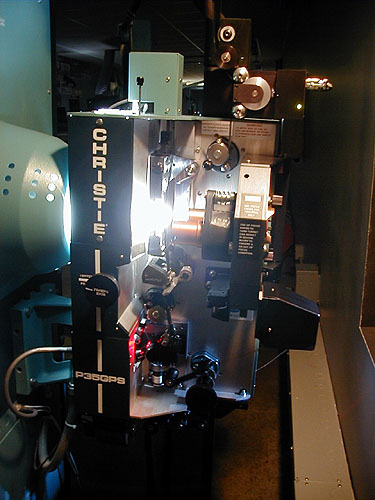

Ahhh, the Christie projector. Most people should be familiar with this machine to some degree. Christie offers the projector at an almost irresistable price when you purchase it along with their brand of lamphouse and platter. This is typically called the "Christie Package".
Many chains have been installing the Christie package out of habit for several years. Take United Artists, for example. They had installed the Christie package in every new theater that they built in the Denver area (and others) since about 1994 or earlier. When a UA technician pushed for STRONG equipment in one of the new theaters that was going up, he met with great resistance. UA just didn't want to put out the effort in obtaining different equipment since they had everything already set up with Christie, and of course they certainly didn't want to pay a higher price for a better projector . The UA tech eventually got his way, but only for that one theater. And word has it that he almost lost his job over it.
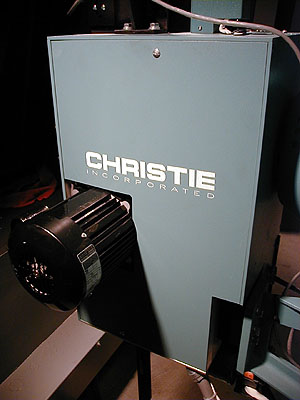
But is this projector really worth that kind of loyalty? Are Christie's customers really getting the good deal that it looks like they are getting on paper? Let's try to answer those questions.
First of all, it should be noted that Christie changed the design of their projectors several years ago to get rid of the gears. Now it is driven by three belts and a bunch of pulleys. It does not require the user to add any oil. It was designed to be virtually "maintenance free". But in fact, the Christie is probably one of the most maintenance intensive projectors out on the market today...and yes, the projector does require oil for some things such as pad rollers and bearings.
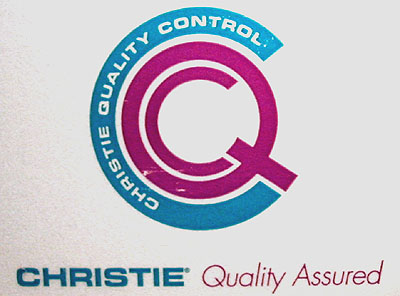
Personally, I find the Christie projector extremely easy to work on. But there are a couple of reasons for that. The first would be Christie's design. Everything is fairly open and easy to get to, and the major components are usually an easy-to-change assembly. The other reason would be that since I have to do so much work on the Christie projectors every week, I have it memorized better than the back of my hand.
What requires so much work? For one, the belts are not exactly the most durable thing on the planet. Especially the shutter belt, which is extremely thin, short and sports a twist. Check out the belt in the picture below. That's a superb engineering design there.
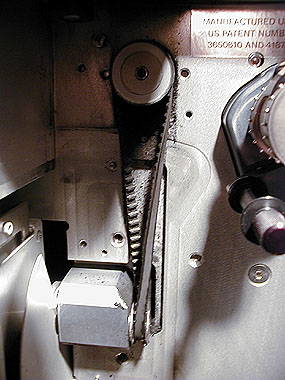
The notches on this are tiny and will wear out on a dime. Fortunately the shutter belt can be replaced and the shutter retimed within ten minutes. The belts should all be replaced about every six months per projector. It's a dirty job since the belts shed terribly and if you've got a megaplex of these to deal with, you're in for a real treat.
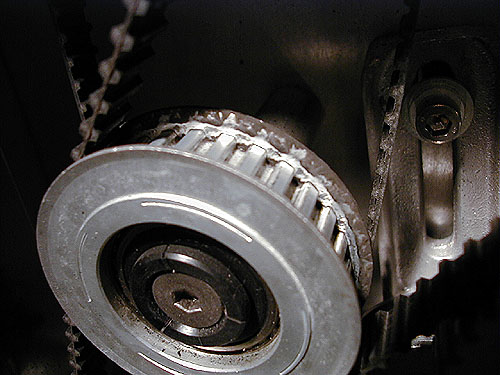
Christies new belt dressing helps prevent the belts from shedding, but only slightly. These pictures of the belts were taken less than six months after they were installed, and belt dressing was applied at that time of their installation. Notice how yucky everything looks! And yes, I cleaned the entire gearbox during the change as well. If you make those belts just a bit too tight, the projector will physically shake badly enough to blur the picture on the screen and the shedding will be outrageous. If you make those belts just a little too loose, the projector will physically shake badly enough to screw up your SRD basement reader and the belts will "jump notches", causing your loop sizes to change. It's a real tricky adjustment and even the Christie techs don't have a rule to go by. But not to worry, once you've ran a booth with these machines for six months, you will indeed be a master at it.
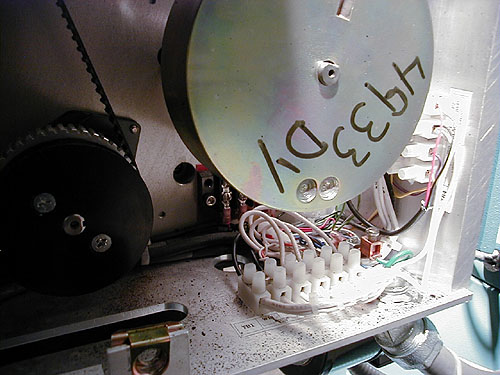
Set up of the Christie projector also adds to the total installation time. Since the aperture cannot be removed without jogging the turret about halfway around, you must take the time to do this each and every time, even if you only need to make a slight adjustment on the plate. The annoyance factor is quite high and the time wasted on cutting apertures is even higher. It is also important to note if your theatre will be presenting scope movies in their full aspect ratio that it is incredibly difficult to get good lower corners on this plate, due to the design of the backside.
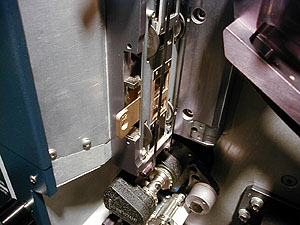
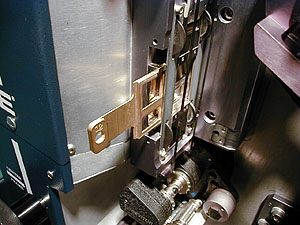
Now you're probably saying "Who cares? So cutting the plates is a major pain. Hey, I don't have to do it. How does this affect how the projector performs, you stupid moron of a reviewer?!" Well, it doesn't really, it's just annoying. Another thing that is very annoying is the airpot. Check it out below.
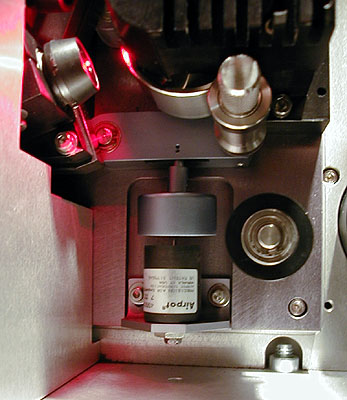
Look how easy it is to break! See that little teeny tiny shaft no thicker than the lead inside of a pencil? The entire assembly is reliant on this wimpy little "pole". In fact, if you have a brainwrap or something similar with polyester film, it will pull tight and litterally destroy the airpot, rendering it completely useless. A new airpot must then be purchased from Christie. This is how they get you. They give you the projector for cheap, but then make 20 times that amount back since they know you'll be replacing parts on the machine constantly. And since the parts gradually get made out of cheaper and cheaper components, they will break even more often and that's even more $$$ for Christie. Ka-ching! Christie loves you.
Now don't think that simply purchasing a replacement air pot will do the trick. Oh no. The airpots are sent out of the factory with a shaft that is just barely too long. This is yet another trick because if you don't snip off the tip end of that shaft before installing it, it will snap within a week's time from the stress on startup! Whoops, there you go buying ANOTHER air pot from Christie. Also of importance is the placement of the adjustment hole (just below the airpot). Most failsafes (including Christie's) are right in the way of this important adjustment.
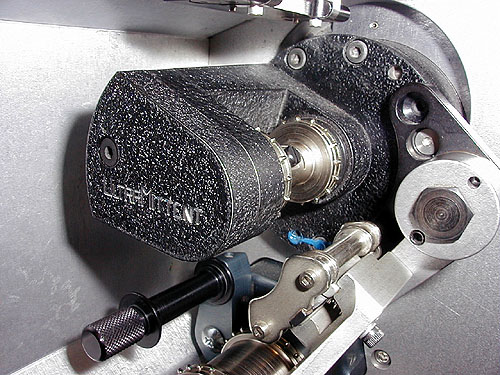
The Christie projector is much too good to have an intermittent sprocket assembly. They must have an "Ultramittent". So what the hell is so damn "ultra" about it? Lots of fun things! For one, it is "ultra" loud. Many of these begin to emit a horrible knocking sound, and it can often be heard in the auditorium! That sucks! They are also "ultra" annoying to change out, since that has to be done so often. I had to replace five of these beauties in the first year of operation at my theater. Five. According to the product literature these Ultramittents are supposed to be maintenance free! Of course, each unit has a different stopping point for the sprocket, so you must reframe the first time you use it. The unit also produces an "ultra" shaky picture onscreen. It is really bad compared to other projectors on the market today, and quite possibly the worst of them all. Of course, since Christie is located in California, the picture is probably perfectly steady to them due to all of the earthquakes. The ultramittent and the earthquakes cancel each other out, giving a smooth, steady picture (but only in California)!
The Christie projector also does not treat your polyester film very well. The gate and trap are made out of extremely rough material. With certain print stocks the shedding is absolutely unbelievable. But with normal prints the shedding is still present and very messy. This will scuff up your film and destroy your SDDS and Dolby Digital tracks as well if you are not using FilmGuard to protect them. This is definitely the reason why users of Christie projectors have digital playback problems even with penthouse readers. Cleaning this out is also a fun chore which only adds to the time it takes to thread. The following picture was taken after a single run of a print (without FilmGuard). Later in the week the print was moved to the theater down the street where they have Simplex projectors, and the film only shed lightly during the first run, and then never shed again (significantly). I was there to see this. Of course Christie will tell you to "just change the gate bands", but this only makes things worse guaranteed. New gate bands will never perform as well as older, buffed ones that are smooth from having countless miles of film ran through them. It's just another trick to make more money.
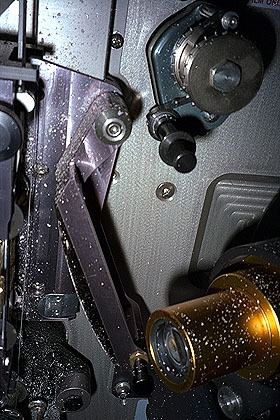
Christie only uses the cheapest material available to maufacture things with. Take their awesome douser plate as an example. After a year (or less) they will start warping. It does not take much to warp it to the point where it can no longer open or close, due to the fact that it can not slide up and down inside the projector. The plate must then be removed from the projector and literally hammered back flat, which is not a fun chore. Once a plate has been warped, it will just warp again and again until you replace it, and you can only hammer it back into shape a few times. Christie's gotcha again! These little pieces of scrap metal aren't as cheap as you think. Well, Christie doesn't pay much for them, but you do.
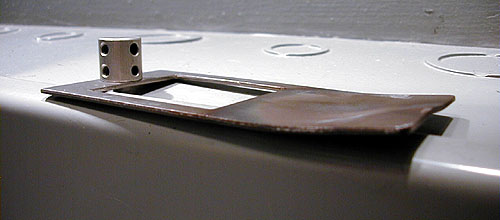
And what the hell is up with Christie's basement Dolby Digital reader? Seriously! This has got to be one of the most poorly engineered devices that I have ever seen! Quality can vary greatly. One week you have the thing tracking 2-3's on your print. The next week you change prints and the thing is tracking all F's. Christie will tell you that it is obviously the print's fault. But play both prints on a Cat701 penthouse reader and both prints will track aound 2 or 3 at the most. We have done this experiment several times.
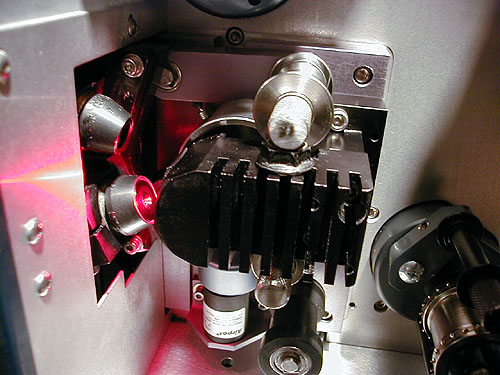
In short, the Christie basement readers must be calibrated for each print. It offers sporadic results AT BEST. Basically what must be done for every new film ran in a particular auditorium is the print must be ran while someone in the booth monitors the settings and makes adjustments with the help of Dolby's DRAS10 software. The Christie basement readers are so sensitive that even if you get the feature running at a good rating (we've achieved a "0" rating on a couple of features believe it or not), the trailers will most probably NOT track properly. Below is a typical screenshot of the DRAS10 software running a new print in a house that was perfectly tweaked the week before to track well on a different print.
See the history plot at the top of the screen? There shouldn't be any red error marks on it, but this just isn't the case on a Christie basement reader. Notice the corners are reading a solid 99, the focus is at 74, azimuth is 1, the lateral position is 0.36 and the vertical jitter is 3.69. These are just about the best possible readings from a Christie. In fact, if it weren't for the little nut on the upper sound drum lateral guide arm two pictures above, the vertical jitter would be running about 6-7! This screen was shot after replacing the led with a new one, swapping the led power supply from a projector that was known to be in good condition, changing the sounddrum bearings with new ones, installing a new sounddrum shaft and installing a new lens. The error history above also represents the best reading we could get from adjusting the led's intensity. Yet the reading is a nice big FAULT! It is interesting to note we intentionally misaligned a Dolby penthouse reader and it was still able to play the film without error.
Above is a shot of one of Christie's LEDs. It doesn't take a rocket scientist or a magnifier to see the LED slit isn't even mounted perpendicular to the direction of the film! Upon inspecting the LEDs in my booth, I have found that the only few readers I can get to track somewhat decently have slits that are perfectly horizontal. NONE of the leds that are mounted with a slant to them (like the one shown above) will track regardless of adjustment.
Christie has given us next to no support on getting these things fixed. It seems like they don't want to admit that there is a problem. The LED power supply for the basement reader is located in the back of the projector. It is essential that this be adjusted to obtain the best reading. In many cases, we find that the adjustment on it just keeps on turning and turning, making no difference in the video voltage level. Upon informing Christie of this, their advice was simply to "change the LED". What? How will that fix the bad pot? We changed the LED anyway and the problem was still there. Shame on you Dolby for letting such a horrible product bear your name!
Christie will respond if you e-mail them about something, but don't ever expect them to respond publicly on the Film Handler's forum despite the fact that they visit the site daily, lurking quietly. After all, we can't have people asking questions on this site where the general public will see just how many people are having problems with their equipment, now can we? Yes, the best solution is definitely to lurk quietly and not even consider representing their products, assisting projectionists and techs like basically ALL of the other manufacturers do on this site. If someone does post a problem they are having with Christie equipment, it is far better to quietly shut them up via private email than to let such problems be public. That's a great attitude.
Overall I'd have to say that the support they give their products is very very bad, probably the worst in the cinema industry. The only time a Christie technician has been to my theater was when they were in town for another reason. I have requested Christie techs on many occasions. We are having problems with just about everything Christie, from the projectors, basement readers, and platters all the way to our CA21's. Christie simply says "A tech will definitely stop by your theater the next time one of them is in town." That's the best that they can do. Sure, they might be willing to come to your theater if you are a huge mega-chain who may build more theaters and buy more Christie equipment, but they definitely won't help the little guy. This is fact! We have so many things wrong with our Christie equipment and the most that any Christie tech has ever spent out here was two hours, because he had to rush and catch a flight because there are so many theaters that use these projectors desperate for help.
Overall it is a shame that so many people purchase these trouble-prone projectors simply because that's what they have always purchased or are purchasing them based upon their price tag. This really needs to change or film will get a very bad name. Maybe this is all Christie's way of making their digital projector more appealing to future customers by making film look bad now. But no matter what, you will lose in every way if you purchase a Christie P35GPS projector. As far as Christie backing any product they sell, forget it. It won't happen because remember, nothing is their fault. Just take a look at this "Christie rep troubleshooting manual and FAQ" manual I mysteriously got ahold of from the Manual Warehouse.
Bottom Line: It may or may not be the worst projector of all time, but it's certainly the worst projector that I have ever had the displeasure of using.
The views contained herein do not necessarily reflect the views of the publishers of this website. The published views express actual testimony to personal use of particular products or services. The testimonies, good or bad, are based on fact and thereby releases any and all people of any slanderous liability including the author. Anyone who views this portion of the website must accept these views as statements of the author of that opinion based on actual use of the product and/or service.